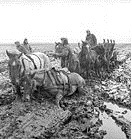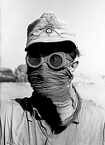Redmarkus5
Posts: 4456
Joined: 12/1/2007
From: 0.00
Status: offline

|
quote:
ORIGINAL: el hefe
Two reasons. The first is that you can never program in the historical human factor in decision making. Second, the players know far too much about the strategic sitaution than the actual combantants did. I will preface my statements here by saying that I do not know if the game 100% accurately portrays isolated units' ability to fight.
Also, everyone likes to use the Stalingrad pocket as the benchmark of how well isolated German units fought compared to the game. It seems to me that many people believe that 6th Army fought under a continuous and furious hail storm of Soviet assaults from 19 November 1942 until its final surrender on 31 January 1943. So why can't the 6th Army in game hold out the 10 turns that they did historically?
Fact is that the assault on the pocket was not a furious and continuous assault on the 6th Army. In less than a week after the encircelment was completed, Stalin ordered a halt to further attacks on the kessel until a plan was devised and reinforcements brought in. The Soviets would not launch a major assault until 10 January or about 5-6 turns. When it did launch its assault, it was composed of seven infantry armies without any Tank Corps or Mechanized Corps. Within a week of this assault, the 76th, 384th, 44th, 376th, 3rd Motorized, and 29th Motorized Divisions were almost completely destroyed and had to retreat into Stalingrad proper. The average strength of these divisions was 600 men. On 17 January, the Soviets paused again for a week to resupply and consolidate. On 22nd January, the Soviets launched its next assault pushing the Germans into Stalingrad proper with the Germans finally surrendering on 31 January 1943.
So where does the human element come from? Well, any human player worth his salt is probably just going to mass his force and crush the Stalingrad pocket which it can because a Soviet player already knows his strength and the German weakness. We already know the sad shape of the 6th Army and how it drained its strength on the assault of the city. We also know that those Tank Corps and Mech Corps as well as the new Rifle Corps are pretty powerful units. The real Soviets in 1942 didn't know these things. It was late Novemeber before Stalin realized how many troops they had actually encircled and then decided to delay to assault to make sure they were ready because he did not have confidence that his forces on the ground could do the job.
I would be interested to see the results of a human vs. human game in "Red Army Resurgent" which tries to replicate the actual attack. The Soviets get the first two turns to encircle and assault the pocket. Once the pocket is airtight, the Soviets have to sit under 10 January to launch its attacks and it can't use Tank and Mech Corps to launch its assaults.
Trey
Everything you say above is true and I really like your scenarios, but the main reason why human players attack the Stalingrad pocket in your "Red Army Resurgent" case is that they can see the 6th Army's CV values plummet immediately after the encirclement. Until that is fixed in the game engine, human WiTE decision making is going to be based on a completely different set of factors to Soviet decision making and is unlikely to take the same direction without loads of house rules etc.
I would prefer to see the game provide a basis for such large pockets to hold out for a few months in certain cases, especially when based on a large industrial city post-41, and to present a sufficient threat/defense capability that the human player has to proceed carefully. As you say above, Stalin didn't have confidence that he had the forces to do the job. When I played the scenario I had 100% confidence I could wipe 6th Army from the map in 2 turns due to the massive CV hit.
_____________________________
WitE2 tester, WitW, WitP, CMMO, CM2, GTOS, GTMF, WP & WPP, TOAW4, BA2
|
 Printable Version
Printable Version











 New Messages
New Messages No New Messages
No New Messages Hot Topic w/ New Messages
Hot Topic w/ New Messages Hot Topic w/o New Messages
Hot Topic w/o New Messages Locked w/ New Messages
Locked w/ New Messages Locked w/o New Messages
Locked w/o New Messages Post New Thread
Post New Thread